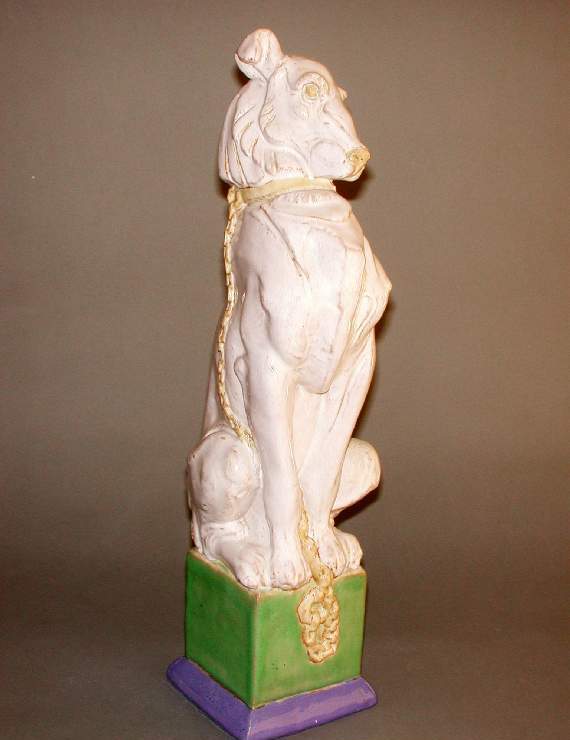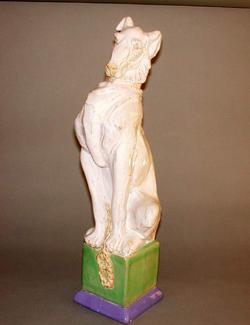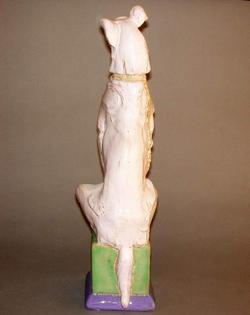Current Location: Gallery 27 (Glaisher)
Titles
Seated hound
The Guardian
Maker(s)
Pottery:
Doulton & Co.
Designer:
Bayes, Gilbert
Entities
Categories
Description
Tall stoneware animal figure, painted in white, cream, blue and green slips, and salt-glazed.
The hound, with its chest thrust forward and its ears cocked, sits on a narrow, square pedestal. Its front paws are neatly placed between its hind paws, and its tail hangs down behind. It wears a collar with a chain which winds down the hound's right side and between its front paws, then loops up to a ring on the front of the pedestal. The dog’s eyes, nose, collar and chain are pale brownish-ochre; its body is white. The pedestal, roughly a cube, is mid-green, and sits on a wider mid-blue base. The underside is unglazed, with a large central aperture opening into the hollow centre of the figure.
Notes
History note: Purchased by the Friends of the Fitzwilliam Museum from The Fine Art Society, London, 31 October 1995.
Legal notes
Given by the Friends of the Fitzwilliam Museum
Measurements and weight
Height: 49.5 cm
Height: 19.4 in
Acquisition and important dates
Method of acquisition: Given
(1995)
by
The Friends of the Fitzwilliam Museum
Dating
20th Century, Early
Production date:
AD 1935
: Dated on pedestal; see inscription.
Note
Doulton and Co, founded c.1815, originally made utility ceramics, with some stoneware jugs and ornamental bottles. Henry Doulton introduced decorative stoneware and architectural terracotta at Lambeth in the mid 1860s, encouraging designers, modellers and decorators to use a wide range of techniques and decorative treatments in producing both unique, artist-signed, and limited edition pieces. From 1872 the business expanded into faience and in the 1880s opened a factory at Burslem, Staffordshire, where bone china and other wares were made. In 1901, Edward VII granted the Royal warrant to the factory. Stoneware production at Lambeth reduced after 1914, and ceased in 1956.
The sculptor Gilbert William Bayes RA (1872 – 1953) was born in London, into a family of artists. He was associated with Doulton’s Lambeth Pottery for over thirty years, making coloured, salt-glazed stoneware for architectural use, and became President of the Royal Society of Sculptors (1939-44). His ‘Pottery through the Ages’ ceramic frieze, originally on the façade of Doulton’s Albert Embankment headquarters, is now in the Victoria and Albert Museum’s ‘The Gilbert Bayes Sculpture Gallery’. This large animal figure, found in several different sizes and colours, is thought to have been made as a washing line finial for St Pancras Housing Association estates, for which Bayes also made sculptural panels.
People, subjects and objects depicted
Components of the work
Decoration
composed of
slip
( white, green, blue, and pale brownish-ochre)
Base
Depth 12 cm
Depth 12 in
Width 12 cm
Width 4.7 in
Materials used in production
Salt-glaze
Stoneware
Techniques used in production
Salt-glazing
: Buff stoneware with white, green, blue and pale brownish-ochre slips and salt-glazed.
Inscription or legends present
- Text: GILBERT BAYES/1935
- Location: On viewer's right of pedestal
- Method of creation: Incised
- Type: Mark
References and bibliographic entries
Identification numbers
Accession number: C.18-1995
Primary reference Number: 72705
Stable URI
Audit data
Created: Saturday 6 August 2011
Updated: Tuesday 30 April 2024
Last processed: Tuesday 13 May 2025
Associated departments & institutions
Owner or interested party:
The Fitzwilliam Museum
Associated department:
Applied Arts






